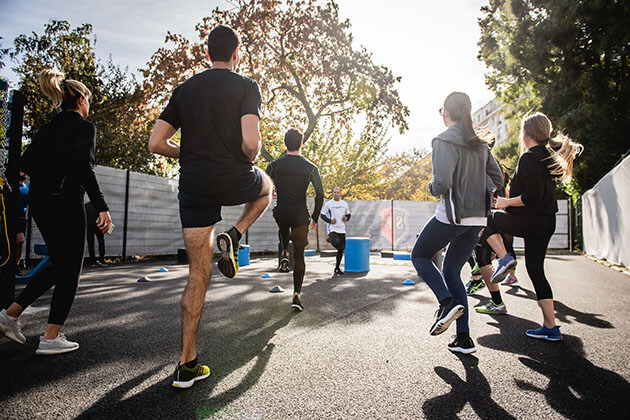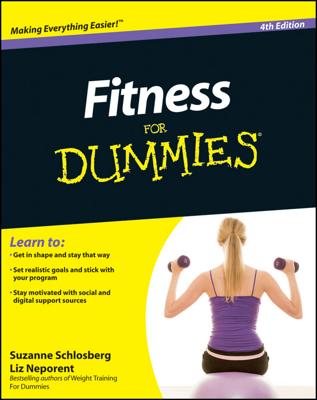 © Gabin Vallet / Unsplash.com
© Gabin Vallet / Unsplash.comKeys to fitness success
Setting fitness goals and making a concentrated effort to meet them are key to getting in shape. The following tips can help you meet your fitness goals:
-
Set realistic, measurable goals. Instead of vowing to “get in shape,” commit to walking 20 minutes, three times a week.
-
Get your fitness tested. Testing pinpoints the area(s) you need to work on, such as your cardiovascular conditioning, strength, flexibility, or balance.
-
Keep a daily exercise diary. Record how far you walked, how hard you pushed, how many sets of shoulder exercises you did, and how you felt during your workout.
-
Work out with a buddy or join a club. You’ll gain more motivation — and fitness — than if you exercise alone. Just make sure your buddy is reliable and motivating. If you’re Internet-savvy, countless websites bring together like-minded fitness buffs to discuss their training, share tips, and talk through challenges. Search Facebook, LinkedIn, or Twitter to find a group.
-
Pace yourself. Don’t do three hours of exercise or attempt to lift 250 pounds your first time out. You’ll burn out fast and may even get injured.
-
Train for an event. Nothing keeps you motivated to exercise like being on a mission, whether it’s to finish a 5k walk or 50-mile bike ride. The feeling of accomplishment you get from completing your event is like nothing else.
-
Have the right gear. You don’t have to become a fitness gear junkie, but having the right clothing and equipment keeps you safe, makes you comfortable, and gets you fired up to work out.
-
Educate yourself. Keep up with exercise trends and techniques by reading Web sites, blogs, and books.
Getting cheap fitness gear and instruction
Improving your physical fitness doesn’t have to cost an arm and a leg — look for ways to cut costs on fitness equipment and exercise instruction. Sure, you can buy a fancy gym membership, spend $200 an hour on a trainer, or buy a $4,000 treadmill that does everything short of fix you an espresso. But you can become just as fit, toned, slim, and flexible spending virtually nothing. Here’s how:
-
Instead of buying dumbbells, lift cooking-oil or cleaning-liquid bottles filled with sand, pebbles, or water. Many bottles are indented in the center (just like a dumbbell), so they’re easier to grip than a soup can. Wear a filled backpack to add resistance to lunges and squats.
-
Buy a jump rope (oh, and use it, too). You can get one for less than $8. Jumping rope strengthens your cardiovascular system, improves your agility, burns up to 15 calories per minute, and tones your thighs, calves, abdominals, back, chest, and shoulders. Plus, you can take your rope with you anywhere.
-
Invest in a physioball. For about $30 to $50, you can buy a giant, sturdy plastic ball, one of the most versatile pieces of exercise equipment around. You can kneel on the ball to improve your balance, lean back on it to do strength exercises, or drape your back across it to stretch out your spine.
-
See whether your cable operator offers ExerciseTV on demand. This means you can fire up a workout any time. Some of these workouts are the same found on DVDs available for sale. If you’re already paying for cable, the workouts are free.
-
If you already own an MP3 player and computer, flip to the podcast section of iTunes. You can find tons of free workout podcasts, both audio and video, for everything from yoga workouts to running techniques. You also can find some free, high-quality workouts on sites such as YouTube.
-
Sign up for joint personal-training sessions with a friend. This has become more popular and acceptable over the past few years in both clubs and in home training. Choose a friend who’s at a similar fitness level as you.
-
Look for nonmotorized equipment on Craigslist or eBay, or get it via giveaways on Freecycle. For used higher-end equipment, go through an authorized dealer that gives you a warranty. When you buy new, ask for a discount, and if you’re buying several items, ask the salesperson to throw in a complimentary accessory, such as a rubber floor mat. Also ask about interest-free payment plans.
Judging fitness articles and news reports
News about fitness studies and developments is often contradictory, even misleading. When you’re wading through fitness news, the following tips can help you pick out reliable sources on TV, online, and in print.
-
Look for context. Does the news report mention how this “revolutionary breakthrough” fits in with previous developments? One new study may be an aberration.
-
Consider the credentials and possible biases of sources quoted. A fitness study is more likely to be legit if it comes out of a major university or government agency rather than some mysterious private institute.
-
Beware of celebrity endorsements. When a celebrity gives media interviews about a disease or plugs a medical treatment or fitness regimen, chances are that person is getting paid, especially if he or she says, “I feel it’s a miracle.” Being a movie star doesn’t make you an exercise expert.
-
Don’t assume cause and effect. If a study says oat bran is “associated with” low cholesterol, this doesn’t mean eating oat bran causes low cholesterol.
-
Look out for advertorials. These are paid ads designed to look like articles, with layouts, fonts, and photos similar to the website or magazine’s editorial style so that readers have to work hard to make the distinction. They’re the written version of infomercials.
-
Notice the length of a study and the number of subjects. A four-week study of ten people doesn’t tell you whether a weight-loss pill or exercise regimen is safe or effective. Maybe a pill stops working after two months or a year. Maybe those ten people aren’t typical.
-
Don’t make too much of animal studies. The way an obese mouse responds to a diet drug may not be the same as the way humans do.
Getting the kids to exercise
Helping your kids get off the couch and in shape prepares them to become healthy adults. Here’s how to tap into children’s natural love of movement and get the whole family in shape:
-
Plan new traditions. Is Saturday morning a time for sausage and pancakes? What about replacing that with a brisk walk to the local park or a bike ride around town?
-
Make physical activity a family policy. You may even have to make exercise mandatory. But after kids get rolling, they won’t fight it anymore.
-
Limit screen time by keeping a television and computer out of your child’s bedroom. Only 30 percent of kids say they have time limits on watching TV, playing video games, or using the computer. But when parents do set limits, children cut screen time by a whopping three hours a day.
-
Take adventure walks in the neighborhood or the woods. Or take your kids to the park to play soccer, Wiffle ball, or kickball, or climb on the jungle gyms. Toddlers love games like red light/green light and Simon Says.
-
Put fun first so kids don’t feel judged by their sports performance. Instead of incessantly correcting their form or praising them for their skill on the soccer field, let them find their groove and focus on the great time they’re having.
-
If your kid is a gamer, consider an active game. Games like Wii Fitness and Dance Dance Revolution burn calories and develop coordination while providing plenty of fun and entertainment.
Fitness myths debunked
The exercise community has its share of fitness myths, misconceptions, and half-truths. The following table lists some of these common fitness myths and the reality behind them.
| Myth | Reality |
|---|---|
| You must exercise for 30 consecutive minutes. | Three 10-minute sessions of exercise burn as many calories and provide nearly the same health benefits as one 30-minute session. |
| Lifting weights will turn you into a pro wrestling contender. |
Virtually all women and most men can’t develop huge muscles without spending hours a day in the gym lifting very heavy weights. |
| If you stop exercising, your muscles will turn to fat. | They’ll just shrink. Fat and muscle are two different entities; you can’t turn one into the other. |
| By focusing on abdominal exercises, you can lose that beer gut. |
You can’t selectively zap fat off a particular part of your body. To lose a beer gut, you need to lose weight and exercise (and you need to cut down on the brewskis). |
| Exercising during pregnancy increases the rate of miscarriage or birth defects. |
With a doctor’s approval, prenatal exercise is very healthy for you and your baby. In fact, studies show that labor and delivery are easier for women who exercise during pregnancy, as is getting back to your pre-pregnancy weight. |

